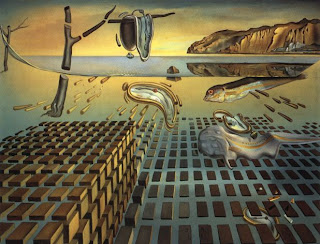
Composition 10
Some of the most renowned and acclaimed Abstract artists were as follows
- Piet Mondrian (1872-1944) Dutch
- Fernand Leger (1881-1955) French
- Barnett Newman (1905-1970) American
- Theo van Doesburg (1883-1931) Dutch
Realism

Some of the most renowned and acclaimed Realist artists were as follows
- Gustave Courbet (1819-1877) French
- Honoré Daumier (1808-1879) French
- John Singleton Copley (1738-1815) American
- Francisco José de Goya y Lucientes (1746-1828) Spanish

The Disintegration of the Persistence of Memory
Some of the most renowned and acclaimed Surrealist artists were as follows
- Salvador Dali (1904-1989) Spanish
- Rene Magritte (1898-1967) Belgian
- Joan Miro (1893-1983) Spanish
- André-Aimé-René Masson (1896-1987) French
- Max Ernst (1891-1976) German
Abstract Expressionism "gestural abstraction”
Modern technique of splashing, throwing and pouring paint on canvas, where the resulting work often emphasizes the physical act of painting itself as an essential aspect of the finished work or concern of its artist. A style that relies on the physical movement of the artist in using such techniques as vigorous brushwork, dripping, and pouring. Dynamism is often created through the interlaced directions of the paint, allowing it to form its own shapes. It was invented by the US painter Jackson Pollock.
Some of the finest examples of this style are Number 1, 1950 (Lavender Mist), One: Number 31, Painting Number 2; 1954, Woman V, Seated Woman on a Bench, bronze of 1972 (cast 1976), Hot Still-Scape for Six Colors - 7th Avenue Style.
Some of the most renowned and acclaimed Abstract Expressionistic artists were as follows
- Jackson Pollock (1912-56) American
- Franz Kline (1910-1962) American
- Willem de Kooning (1904-1997) Dutch
- Stuart Davis (1892-1964) American
Pop Art
Style which emerged in the late 1950’s and early 1960’s. It presented art in terms of popular culture and was to be accessible to all. It made use of the imagery, styles, and themes of advertising, mass media, and popular culture, comic strip cartoons, and images of film stars, often enormously enlarged and garishly painted. Graffiti is a Pop Art as well as Anime in Japan.
Some of the finest examples of this style are Drowning Girl, The Head, A Bigger Splash, Just What Is It that Makes Today's Homes So Different - So Appealing?, On the Balcony, Head of Invention, Numbers, Canyon.
Some of the most renowned and acclaimed Pop Art artists were as follows
- Roy Lichtensetein (1923-1997) American
- David Hockney (1937- ) British
- Richard Hamilton (1922- ) British
- Sir Peter Blake (1935- ) British
- Sir Eduardo Paolozzi (1924-2005) Scottish
- Andy Warhol (1928-1987) American
- Jasper Johns (1930- ) American
- Robert Rauschenberg (1925-2008) American
Video and Computer Art
Movement that emerged in the 1980’s and 90’s, as artists began to explore possibilities of electronic technology.
Video art relies on moving pictures and comprises video and/or audio data. Video art is still widely practiced and has given rise to the widespread use of video installations, which is a method combining video technology with site-specific, three-dimensional works designed to transform the perception of a space. The key difference is that video art does not necessarily rely on employing the use of actors, may contain no dialogue, may have no discernible narratives or plot, or adhere to any of the other conventions that generally define motion pictures as entertainment.
Computer art is where a computer has been involved in production or display of the artwork. Such art can be an image, sound, animation, video, CD-ROM, DVD-ROM, videogame, web site, algorithm, performance or gallery installation. Computer art is by its nature evolutionary since changes in technology and software directly affect what is possible.
Some examples of this style are Pope Paul VI's procession through New York City in the autumn of 1965, Wipe Cycle, Cremaster Cycle, Picture by drawing machine 1, Sprial Sphere and Julia, Detail, a computer-generated image.
 Picture by drawing machine 1
Picture by drawing machine 1
Some of the most prominent Computer and Video artists
- Laurie Anderson (1947- ) American
- Nam June Paik (1932-2006) South Korean-born American
- Domingo Sarrey (1948- ) Spanish
- Wolf Vostell (1932-1998) German
